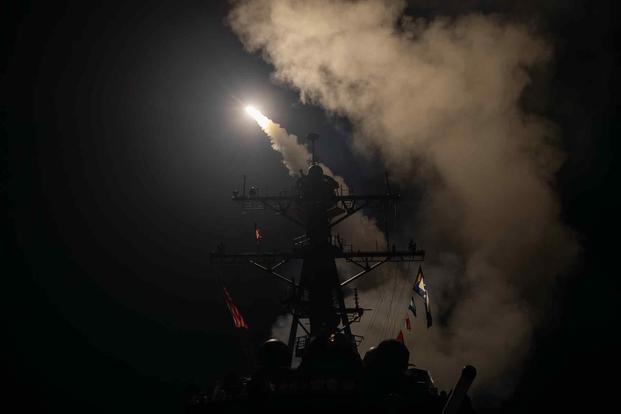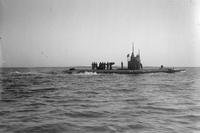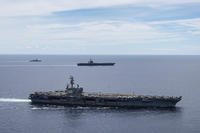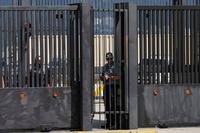As the U.S. military ramps up strikes on Houthi forces in Yemen and militant attacks on troops in Iraq and Syria balloon, Pentagon officials have offered a solid and unflinching answer to a basic question: Are we at war with Iranian-backed rebels?
Pentagon spokeswoman Sabrina Singh offered a fairly simple "no" when asked the question by reporters Thursday. "We don't seek war. ... We are not at war with the Houthis," she added. The Pentagon press corps, seemingly perplexed, noted the increasing number of strikes against the rebel group and asked, "If this isn't war, what is war?"
Despite the unequivocal assurances, the question of war comes amid growing signs that American forces in the region are certainly in combat and approaching a war-like state, drawing more and more skepticism from the press and critics alike.
But experts note that, while such assurances seem at odds with the military realities, they offer political expediency -- though at a cost to the American people and political discourse in the country.
"I don't know that there's any purpose served by being too cute about the way you talk about it," Brad Martin, a former Navy captain turned senior researcher at Rand Corp., told Military.com on Friday. "It's definitely combat, and it is definitely something that could become a much larger combat. ... Whether or not it is at the level that we would call a war is sort of an academic distinction."
Singh on Monday continued to rebut the idea that the U.S. is caught in a cycle of escalation and conflict -- "we don't see conflict" -- even after describing the latest missile barrage on Saturday from an Iranian-backed group against Al Asad Air Base in Iraq as "a larger- scale attack than we have seen before."
The military's involvement in firing ordnance at Houthis and Houthi assets began months ago on Oct. 19, when the destroyer USS Carney shot down four missiles and 15 drones that, at the time, the press was told were bound for Israel.
Meanwhile, just two days prior, a U.S. military outpost in Iraq took fire from attack drones and missiles.
Since then, incidents in Yemen as well as Iraq and Syria have continued at an increasing pace. By early January, the head of the Navy's Central Command, Vice Adm. Brad Cooper, was telling reporters that U.S. ships had shot down 61 drones and missiles in the Red Sea. To date, there have also been 151 attacks on U.S. outposts in Iraq and neighboring Syria.
More recently, the U.S., with help from the British, has begun an open-ended campaign of strikes against the Houthis that officials say is aimed at reducing their ability to launch missiles into the Red Sea. The campaign opened with a massive retaliatory strike on more than 60 targets in Yemen on Jan. 11. Another, similar large strike followed 11 days later.
Adding to the intensity of the conflict is the fact that there is no denying that the attacks in Iraq and Syria are not only targeting American troops but have successfully caused injury. To date, there have been more than 70 injuries -- some were diagnosed as traumatic brain injuries and one injury was so serious that it left a soldier in a coma.
At the same time, military officials have offered mixed messages about what is actually happening in the waters off Yemen.
In talking with reporters in early January, Cooper said that there was "no specific information that any U.S. ship has been directly targeted." At the time, U.S. Central Command was also highlighting the idea that the launches were against merchant vessels by keeping a running tally of the number of Houthi attacks "on international shipping."
While the message to the public has focused on framing the actions as a defensive, merchant-focused effort, the military seemed to tell its own forces a different story.
On Dec. 11, Gen. Michael Kurilla, the head of U.S. Central Command, flew out to the Carney to present awards to 20 of its sailors for their actions in that first, Oct. 19, incident. The ship’s commander also received a Bronze Star.
Despite the fact that in October, Maj. Gen. Pat Ryder, the Pentagon's top spokesman, told reporters that the missiles were targeting Israel, not the Carney, a Navy spokesman was telling reporters that "the team defended the ship and their shipmates from a complex air attack, manifested in the form of multiple hostile air threats traversing the Red Sea."
Then, in January, Cooper presented the Carney with a Combat Action Ribbon -- a prestigious combat award that the Navy has rarely bestowed on its ships.
Navy officials have, so far, been unwilling to provide the citation behind the Combat Action Ribbon to Military.com, and they have yet to offer an explanation for why it cannot be made public.
When Ryder was asked whether the award signified that Navy ships are considered in combat while conducting seemingly defensive operations in the Red Sea, he replied that "the admiral's actions speak for themselves in terms of recognizing the crew ... so let's leave it at that."
As American retaliations gathered in frequency and force, the U.S. began acting more proactively, as well.
Since the planned Jan. 11 strike in Yemen, U.S. forces in the area have carried out five preemptive retaliatory strikes, destroying Houthi missiles before they are able to be launched. U.S. Central Command also began to note that American forces are now determining that the missiles pose "a threat to merchant vessels and U.S. Navy ships in the region."
The latest such strike occurred Saturday and appears to have brought the destroyed missile count to 24.
President Joe Biden said last week that the U.S. military strikes would continue.
Martin, the Rand senior researcher, noted that, despite the increased tempo and intensity of strikes on the part of America, the situation in the Middle East isn't a "war" in the academic sense of the term, which is sometimes defined as more than 1,000 battle casualties during an interaction between two sovereign nations.
"If you apply that, then no, we're not at war. ... We're in something like a punitive action against a non-state actor," Martin said.
Yet Jonathan Lord, a senior fellow and director of the Middle East security program at the Center for a New American Security think tank, told Military.com on Friday that thinking about the term in its political sense is more instructive.
In the political realm, being at war would require authorization from Congress, according to the War Powers Resolution of 1973. The law was passed in the waning years of the Vietnam War -- over President Richard Nixon's veto -- as a way to check the president's power to commit U.S. troops to combat.
One of the key provisions of the law mandates the president notify Congress within 48 hours of hostilities, and that sets off a 60-day count, at the end of which Congress has to authorize further military action.
That request doesn't always go over well. Congress can be reluctant, and disagreement can derail such efforts.
"The way presidents have kind of skirted that issue is that they simply re-notify every time forces enter into hostilities ... resetting the 60-day clock," Lord said. "More likely than not, every time U.S. forces engage the Houthis ... there will probably be a specific and separate notification of that event."
"Has the executive branch basically found the cheat code to avoid [war]?" Lord asked, rhetorically. "It seems so."
Lord noted that the Houthis and various Iranian-backed militias that the Pentagon says are behind the multitude of attacks also benefit from a lack of declared, recognized conflict.
"All of Iran's proxies, and partners, have really attempted to slowly boil the frog in a way that prevents the U.S. or Israel from being backed into a corner or to have to make a dramatic choice," Lord said.
The result is the current situation -- a kind of chess game in which each of the players is able to achieve some of their goals and please their respective constituencies while avoiding all-out conflict. But it also results in the ambiguous, vague language that everyday Americans struggle to parse and understand.
"There's this slow, steady separation between civilian and military worlds that has benefited policymakers," Lord said. "If most Americans can't feel or identify the cost of being at war, they have a freer hand."
But that freedom comes at a cost. Setting aside very high-minded ideas about an informed electorate and the health of public debate, the administration's effort to have the latest conflict in the Middle East play out without public debate or criticism can backfire on it.
"When leaders aren't forthcoming and honest at the onset of what they think a conflict is going to be, ultimately, it constrains their ability to win ... when the public grows tired, or feels like they had a bait and switch, or simply don't understand the purpose of what we're doing," Lord said.
Related: Airstrikes Pound Houthis in Yemen as US and UK Retaliate for Red Sea Attacks on Shipping














